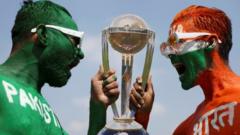Roaring crowds, flags waving, and painted faces; these scenes replicate every time India and Pakistan clash on the cricket field. Yet, the vigor of this rivalry, now spotlighted in Netflix's "The Greatest Rivalry: India v Pakistan," raises critical questions about its current essence.
Virender Sehwag's assertion that this is "bigger than a battle between bat and ball" echoes through history, with both India's R Ashwin and Waqar Younis declaring the rivalry unparalleled. Despite years of political tension and instability, cricket has served as a connecting thread between the two nations. However, recent defeats have sparked debate about whether the rivalry still holds the same intensity or if it's become a relic shaped more by its storied past than present competitiveness.
The lopsided recent performances, such as India’s 228-run triumph over Pakistan in the Champions Trophy, have given rise to critical voices from both sides. Notably, a leading Pakistani newspaper remarked on a supposed "cricket war" that now seems lackluster, while another media outlet characterized Pakistan cricket as sliding into "pity territory." Analysis points towards an ongoing crisis in Pakistan cricket, plagued by missed opportunities and instability, contrasting starkly with India's ascendance as a cricket powerhouse, bolstered by a thriving domestic structure and the Indian Premier League (IPL).
With its players excluded from lucrative franchises and facing a history marred by turmoil, Pakistani cricket's struggles amplify concerns over the rivalry's diminishing quality. Critics argue that the power imbalance turns it into a narrative geared more towards marketing than genuine sporting competition. Nadeem Farooq Paracha and Osman Samiuddin echo the sentiments that the essence of the contest has been hijacked by commercial interests, diluted further by Pakistan's inability to keep pace competitively.
India's vice-captain Shubman Gill asserts the excitement remains intact; with over 600 million viewers for a recent match, it seems public interest is unwavering. However, seasoned commentators worry that the thrill lies more in the hype surrounding the event than the cricket itself.
This rivalry, fueled by its rich history, remains one of cricket's most commercially potent spectacles, yet its competitive edge appears to wane, leaving spectators and analysts alike to wonder if this iconic contest can reclaim its former glory.



















